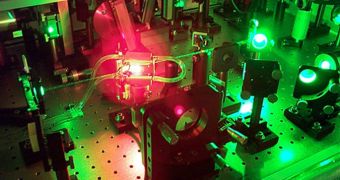The probes, orbiters and rovers that currently explore the recesses of the solar system and beyond are only crude efforts in mankind's quest to explore the Universe. These robots currently come at very high costs, are relatively fragile, and only carry limited amounts of scientific equipment. But, in the future, space exploration will be conducted with formations of spacecraft, flying at predefined distances from each other, and in essence acting like a single, gigantic sensor. These probes will need to be able to maintain the established distance no matter what, and a new report shows that femtosecond lasers are the way this can be achieved.
According to the paper, which was designed by experts at the UK National Physical Laboratory (NPL) for the European Space Agency (ESA), femtosecond comb lasers are the best, most effective way of conducting the highly precise measurements required to keep the elements of a free-flying spacecraft formation in the same relative position in regards to each other. A femtosecond is an extremely small unit of time, equivalent to one billionth of one millionth of a second. Because countless measurements can be conducted within a very short period of time, the distance between spacecraft could be accurately assessed, leaving only a few microns for errors.
The report could have direct effects on the proposed International X-ray Observatory, which is due to launch sometime after 2020. The craft will be more than 25 meters long, and femtosecond comb lasers could be used to determine the exact position of the ship's front in regards to its back. Precision will be key in this case, because the telescope will have a flexible body, and it will twist a lot. Keeping X-ray images in focus will need to be achieved within very narrow margins of error – a maximum of 300 microns in length and 10 arc seconds in angle.
In the case of future probes flying in formation, the new guidance systems will have to work closely with position-establishing systems. Once they reach the correct position in space, the probes will need to accurately assess their positions in regards to known stars, and then use the lasers to determine the distance each of them is from the others. This is, however, the most difficult part of the mission. Once the planned formation is attained, it can easily be maintained using the femtosecond lasers.
Menlo Systems, the Laser Centre Vrije Universiteit Amsterdam, and Kayser-Threde also collaborated with the NPL for this research, which is a part of ESA's High Accuracy Absolute Long Distance Measurement (HAALDM) project.

 14 DAY TRIAL //
14 DAY TRIAL //